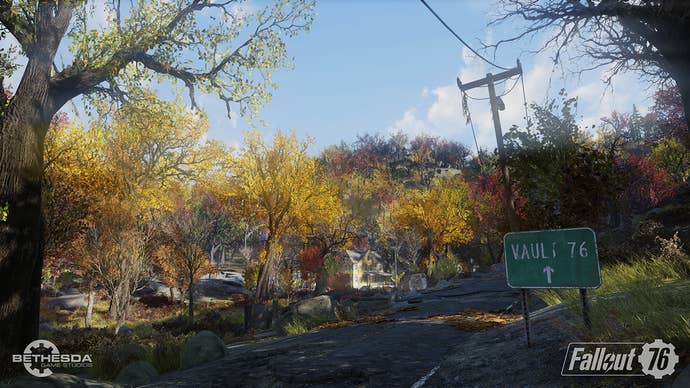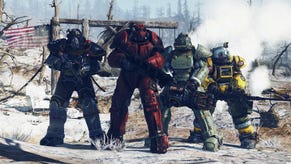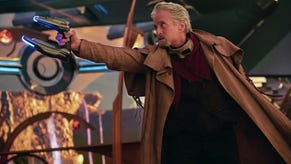The Fallout 76 Beta Drives Home How Weird It Is to Make a Fallout Game All About Combat
With Fallout 76 stripping away most of the narrative, the shaky gunplay feels more exposed than ever.
This article first appeared on USgamer, a partner publication of VG247. Some content, such as this article, has been migrated to VG247 for posterity after USgamer's closure - but it has not been edited or further vetted by the VG247 team.
It hit me right as I encountered my first Protectotron in Fallout 76, which kicked off its beta yesterday. It's cool and all that Fallout 76 is a multiplayer game, but that puts an unusually heavy emphasis on combat. And Fallout's combat is still... kind of bad.
For years now Fallout's combat has been something we've suffered in the name of enjoying its vast sandbox. We've dealt with the janky and unsatisfying gunplay while fending off hordes of ghouls. We've watched as 90 percent headshots have somehow missed at point-blank range. We've joylessly sniped hundreds of super mutants because stealth and sniping are always overpowered in Bethesda's open world games.
Tradtionally, the allure of games like Fallout and Skyrim have been bound up in the sense that you're part of a larger world rather than their actual moment-to-moment gameplay. Some of that is down to their exploration, some of that is down to their little interactions. At their best, Fallout and Elder Scrolls can get you to forget you're playing a game and transport you to the closest thing we have to a holodeck in the gaming space.

Fallout 76, to its credit, definitely has some of those elements. The misty mountains of Appalachia are every bit as compelling as Fallout's previous settings, and West Virginia's lush forests might be the closest the series will ever come to matching the sheer beauty of Elder Scrolls. Upon exiting Vault 76 for the first time, I turned on the radio and bobbed along to a jaunty remix of "Ghost Riders in the Sky" while enjoying the scenery, all of which was very much in keeping with Fallout's aesthetic.
But as I've written before, things are also very different in Fallout 76. On more than one occasion I jumped with surprise when another player abruptly rounded the corner, shattering the illusion of being alone in the wilderness. In the course of exploring an agricultural center, I suddenly found myself in the midst of an "event zone" in which I had to team with other players to take down Protectotrons.
With the multi-layered narrative sidequests the series is know for being virtually absent, combat naturally comes to the fore in Fallout 76. The classic VATs system, which slows the action to a crawl while you target different limbs, has been heavily retooled to suit the new multiplayer mechanics. It now resembles a souped-up auto-aim system, and as Nadia wrote, it takes some getting used to.
After some trial and error, I fell into a pattern wherein I activated VATs, stood very still, and waited for the percentage to jump up to 80 percent (usually as my foe neared point-blank range). Despite the shift to multiplayer, Fallout 76's gunplay is still stats-driven, so it's still very possible to point your gun directly at a giant molerate and have nothing happen when you pull the trigger. This happened to me more than once, and it got to the point where I started avoiding some of the faster enemies entirely.
The result of all this is a weird compromise between the Fallout games of old and more traditional shooters. It's clear that Bethesda wants to ape the success of Destiny in creating a multiplayer platform, but isn't quite willing to abandon the tried-and-true mechanics of old for fear of upsetting longtime fans. Thus, Fallout 76's shooting feels as strange and floaty as ever, but without the benefit of being able to reliably fall back on VATs.
This is on top of a structure that emphasizes combat over narrative. Much of Fallout 76's early hours are spent following the trail of Vault 76's Overseer while exploring ghostly, abandoned towns. The NPCs are all dead, their stories told through audiologs as you crawl through empty buildings.
It reminded me a bit of Fallout 4's Nuka-World DLC, which largely eschewed narrative in favor of a series of dungeon crawls through an abandoned amusement park. It was that DLC more than anything that drove home how tiresome Fallout's combat can become when delivered in large doses. Now we have an entire game built around it.

What Fallout 76 Gets Right
While I'm a bit at odds with Fallout 76's combat, there are other elements that still work relatively well. The crafting system returns intact, and weird as it is to have to literally wait in line for someone to finish using a crafting station, it's still a pleasure to build souped up guns and armor. The crafting is further heightened by a hunger/thirst system that has you boiling water and cooking up Brahmin steaks so you can remain in peak physical condition.
Settlements are also a big point of interest in Fallout 76, and you will consequently spend a lot of time gathering blueprints and raw materials to that end. I established a camp relatively early, and it's a nice feeling to sit by a fire in the woods, a sleeping bag sitting nearby. As in Fallout 4, camps can eventually become whole towns given the time and resources, which figures to be the crux of much of Fallout 76's gameplay.
As always, there's a nice loop to be found in camping out, striking out in the wilderness to find the next quest, then returning to build up your settlement some more. Fallout's world is as beautiful and compelling as ever, and the social features work better than expected, though I'm more inclined to solo play myself. There's something magical about exploring Bethesda's sprawling worlds, and that's true as ever for Fallout 76.

For all of its positive qualities, though, combat remains a sore point, and with narrative receding to the background in Fallout 76, that's more apparent than ever. It's not what I would call gamebreaking, but it really serves to highlight the relative limitations of Fallout's systems. I kind of wish Bethesda had just sucked it up and made Fallout 76 a true shooter rather than attempting the strange compromise we get here.
The shaky combat figures to be further exposed by whatever the endgame ends up bringing. Nadia wrote earlier about the Scorchbeast, a beast that sounds... well... a lot like something you would fight in a raid. That's fine, but if the combat isn't all that fun, it's hard to imagine wanting to stick around for extremely high level play.
We'll see how it all shakes out, but thus far at least, Fallout 76 feels like an odd turn for a series in which combat has never been a strong point. If it ends up falling short when it comes out next month, it'll almost certainly be because Bethesda opted to play to the franchise's weaknesses rather than its strengths.
If you want to learn how to play Fallout 76 early, we've got all the info you need. Head over to our Fallout 76 Beta times page for the latest scheduled session times and details on how to get involved with the beta.

















